|
Combat Skills of
the Soldier
FM 21-75
HEADQUARTERS
DEPARTMENT OF THE ARMY
Washington, DC,
3 August 1984
APPENDIX H
Field Expedient Antiarmor Devices
There are many weapons that you can use to destroy a tank or an armored
personnel carrier. The weapons most frequently used are LAWs, Dragons, TOWs,
mines, and high-explosive dual-purpose (HEDP) rounds of the M203 grenade
launcher. There may be times, however, when you will not have these weapons
available. In such cases, you may have to use field expedient devices. This
appendix describes some appropriate devices.
HOW TO MAKE EXPEDIENT DEVICES
In order to construct some of these devices, you must know how to prime
charges electrically and nonelectrically. (app B).
FLAME DEVICES
These devices are used to obscure the vision of a vehicle's crew and to set
the vehicle afire. The burning vehicle creates smoke and heat that will
asphyxiate and burn the crew if they do not abandon the vehicle.
Molotov cocktail. This is made with a breakable container, a gas and
oil mixture, and a cloth wick. To construct it, fill the container (usually a
bottle) with the gas and oil mixture, and then insert the cloth wick into the
container. The wick must extend both into the mixture and out of the container.
Light the wick before throwing the Molotov cocktail. When the container hits a
vehicle and breaks, the mixture will ignite, burning both the vehicle and the
personnel around it.
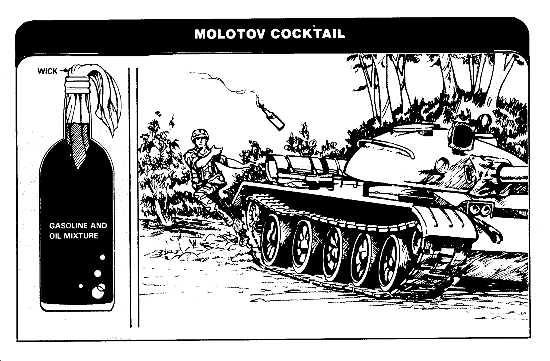
Eagle fireball. This is made with an ammunition can, a gas and oil
mixture, a white phosphorous grenade wrapped with detonating cord, tape, a
nonelectric blasting cap, a fuse igniter, and a grapnel (or rope with bent
nails). To construct an eagle fireball, fill the ammunition can with the gas and
oil mixture. Wrap the grenade with detonating cord and attach a nonelectric
firing system (app B)
to the end of the detonating cord. Place the grenade inside the can with the
time fuse extending out of it. Make a slot in the can's lid for the time fuse to
pass through when the lid is closed. If available, attach a rope with bent nails
or a grapnel to the can. When you throw the can onto a vehicle, the bent nails
or the grapnel will help hold the can on the vehicle. Before throwing the can,
fire the fuse igniter.
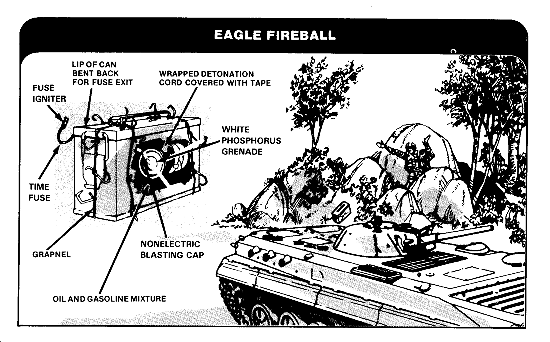
Eagle cocktail. This is made of a plastic or rubberized bag (a
waterproof bag, a sandbag lined with a poncho, or a battery case placed inside a
sandbag), a gas and oil mixture, a smoke grenade, a thermite grenade, tape,
string, and communications wire or cord. To construct an eagle cocktail, fill
the bag with the gas and oil mixture. Seal the bag by twisting its end and then
taping or tying it. Attach the thermite and smoke grenades to the bag using
tape, string, or communications wire. When attaching the grenades, do not bind
the safety levers on the grenades. Tie a piece of string or cord to the safety
pins of the grenades. Before throwing the eagle cocktail, pull the safety pins
in both grenades.
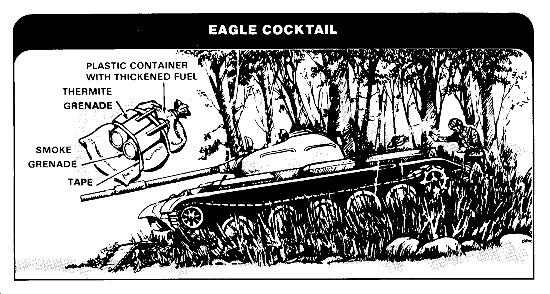
EXPLOSIVE DEVICES
Place such devices at vulnerable points to destroy components of tanks and
armored personnel carriers.
Towed charge. This is made of rope or communications wire, mines or
blocks of explosives, electrical blasting caps, tape, and electrical firing
wire. To construct a towed charge, link a series of armed antitank mines
together with rope or communications wire. If mines are not available, use about
25 to 50 pounds of explosives attached on a board (sled charge). Anchor one end
of the rope on one side of a road and run its other end across the road to a
safe position from which the charge may be pulled onto the road. Attach an
electric firing system (app B)
to each mine (or to the explosive on the sled charge) and connect those systems
to the firing wire. Tape the firing wire to the rope running to the position
from which the charge is pulled onto the road. At that position, conduct a
circuit check (app B)
and then connect the firing wire to a blasting machine. Just before a vehicle
reaches the site of the towed charge, pull the charge onto the road so that it
will be run over by the vehicle. When the vehicle is over it, fire the charge.
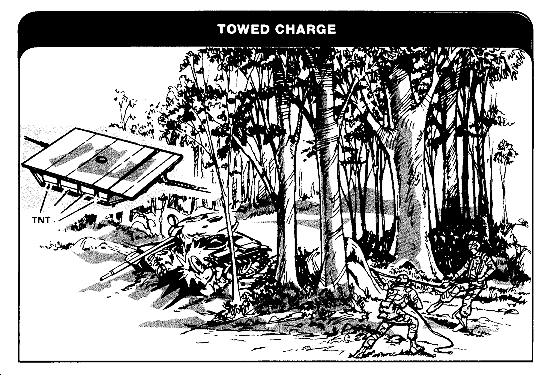
Pole charge. This is made of explosives (TNT or C4), nonelectric
blasting caps, time fuse, detonating cord, tape, string or wire, fuse igniters,
and a pole that is long enough for the mission. Prime the desired amount of
explosives with two nonelectric firing systems, and attach the explosives to a
board or some other flat material. The amount of explosives you use depends on
the target to be destroyed. Tie or tape the board with the explosives to the
pole. The time fuse should only be about 6 inches long. Before putting a pole
charge on a target, fire the fuse igniters. Some good places to put a pole
charge on a vehicle are under the turret, over the engine compartment, in the
suspension system, and in the main gun tube (if the charge is made small enough
to fit in the tube).

Satchel charge. This is made of explosives (TNT or C4), nonelectric
blasting caps, time fuse, detonating cord, tape, fuse igniters, and some type of
satchel. The satchel can be an empty sandbag, or demolitions bag, or some other
material. To construct a satchel charge, fill the satchel with the amount of
explosives needed for the mission. Prime the explosives with two nonelectric
firing systems. Use only about 6 inches of time fuse. Seal the satchel with
string, rope, or tape, and leave the time fuse and fuse igniter hanging out of
the satchel. Before throwing a satchel charge onto a target, fire the fuse
igniters.

WEAK POINTS OF ARMORED VEHICLES
To use expedient devices successfully, you must know where the weak points of
armored vehicles are. Some of the common weak points of armored vehicles are
as follows:
-
The suspension system.
-
The fuel tanks (especially the external tanks).
-
The ammunition storage compartments.
-
The engine compartment.
-
The turret ring.
-
The armor on the sides, top, and rear (normally not as thick as that on
the front).
|
NOTE: THE LOCATION OF SOME POINTS MAY VARY FROM VEHICLE TO
VEHICLE. |
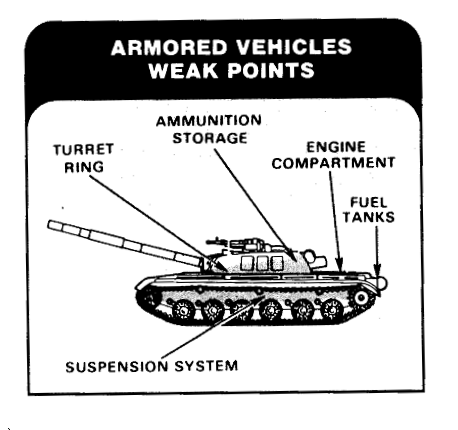
If a vehicle is "buttoned up" and you have no antiarmor weapons, fire your
rifle at the vision blocks, at any optical equipment mounted outside the
vehicle, into the engine compartment, at any external fuel tanks, or at the
hatches. That will not destroy the vehicle, but may hinder its ability to fight.

|
|
Approved for public release;
Distribution is unlimited.
The listing of any non-Federal product in this CD is not an endorsement of the
product itself, but simply an acknowledgement of the source.
Bureau of Medicine and Surgery
Department of the Navy
2300 E Street NW
Washington, D.C
20372-5300 |
Operational Medicine
Health Care in Military Settings
CAPT Michael John Hughey, MC, USNR
NAVMED P-5139
January 1, 2001 |
United States Special Operations
Command
7701 Tampa Point Blvd.
MacDill AFB, Florida
33621-5323 |
*This web version is provided by
The Brookside Associates Medical Education Division. It contains
original contents from the official US Navy NAVMED P-5139, but has been
reformatted for web access and includes advertising and links that were not
present in the original version. This web version has not been approved by the
Department of the Navy or the Department of Defense. The presence of any
advertising on these pages does not constitute an endorsement of that product or
service by either the US Department of Defense or the Brookside Associates. The
Brookside Associates is a private organization, not affiliated with the United
States Department of Defense.
Contact Us · · Other
Brookside Products

|
|
Operational Medicine 2001
Contents
|

|










